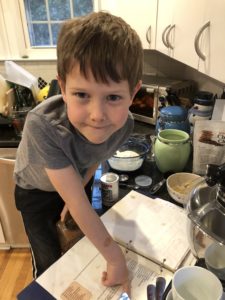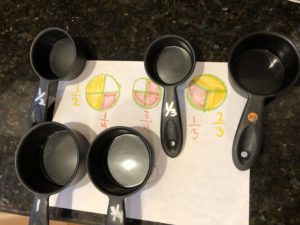 Cooking together is a great way to support language development at home. It’s fun. It’s natural. It’s loaded with endless possibilities.
Cooking together is a great way to support language development at home. It’s fun. It’s natural. It’s loaded with endless possibilities.
Cooking together is always a great way to target and support language development but it’s a particularly great time to do it now that we’re all home for the pandemic.
So just what areas of language can cooking together support?
Vocabulary. Math. Sequencing. Following Directions. Reading. Description. Comparison. Verbs. Planning. Organizing. Measuring. Reasoning. Problem-Solving. Concepts.
That list could likely continue but here are a few language ideas that you can use the next time you’re in the kitchen & sharing a cooking experience.
First, read aloud the ingredients needed, then begin pulling them all out. Allow your child to help find and pull ingredients out. Once you have all of the ingredients, gather all of the tools, bowls, pans you need. Along the way, label all of these items and talk about their use in your recipe.
For toddlers: target specific words. Action words are great–stir, pour, mix, measure. Repeat the words often while pairing it with the actual action. Pair the word with the action while your child is performing the action.
For preschoolers: add in focus on directions and sequencing words– first, next, last, before/after, in, on, under, over, together, all/none, etc.
For elementary & middle school-aged children: allow them to read the recipe, with as much help as they may need of course! Discuss and explain words that may be unfamiliar to them (this grows their vocabulary!) and show them the meaning as well while prepping the ingredients. Have them measure out ingredients and talk about the math concepts. Dry measuring cups are great for targeting fractions and showing what they mean.
Pictured here is an example of I did with my son relat ing his recent math lessons to measuring cups. It was definitely a light bulb moment connecting classroom math with a real-life experience!
ing his recent math lessons to measuring cups. It was definitely a light bulb moment connecting classroom math with a real-life experience!
For children with special needs: use all of the techniques above.
It is important to engage in conversation while you are cooking together about why ingredients are added in at a particular time. The why helps children build their semantic knowledge about cooking, the specific recipe you are making and related topics.
Additional topics that could be discussed include: kitchen/cooking safety, concepts (hot/cold, on/off, wet/dry, etc.), and problem-solving (what to do when an ingredient is missing or the end product didn’t turn out well).
Most importantly, have fun! Let your child scoop, pour, measure and mix even if you don’t like a mess–there is learning happening with the physical tasks as well, such as how to pour without spilling, how to mix without having a plume of flour coating the kitchen and more.
I’d love to see some of your shared cooking experiences–post below!
Speech With Sara offers individual therapy in Grosse Pointe, Michigan, for speech-sound disorders, early childhood language delays, literacy & language deficits and orofacial myofunctional disorders. Have questions about speech and language development or need therapy? Contact Speech With Sara at 313-815-7916 or by email.
